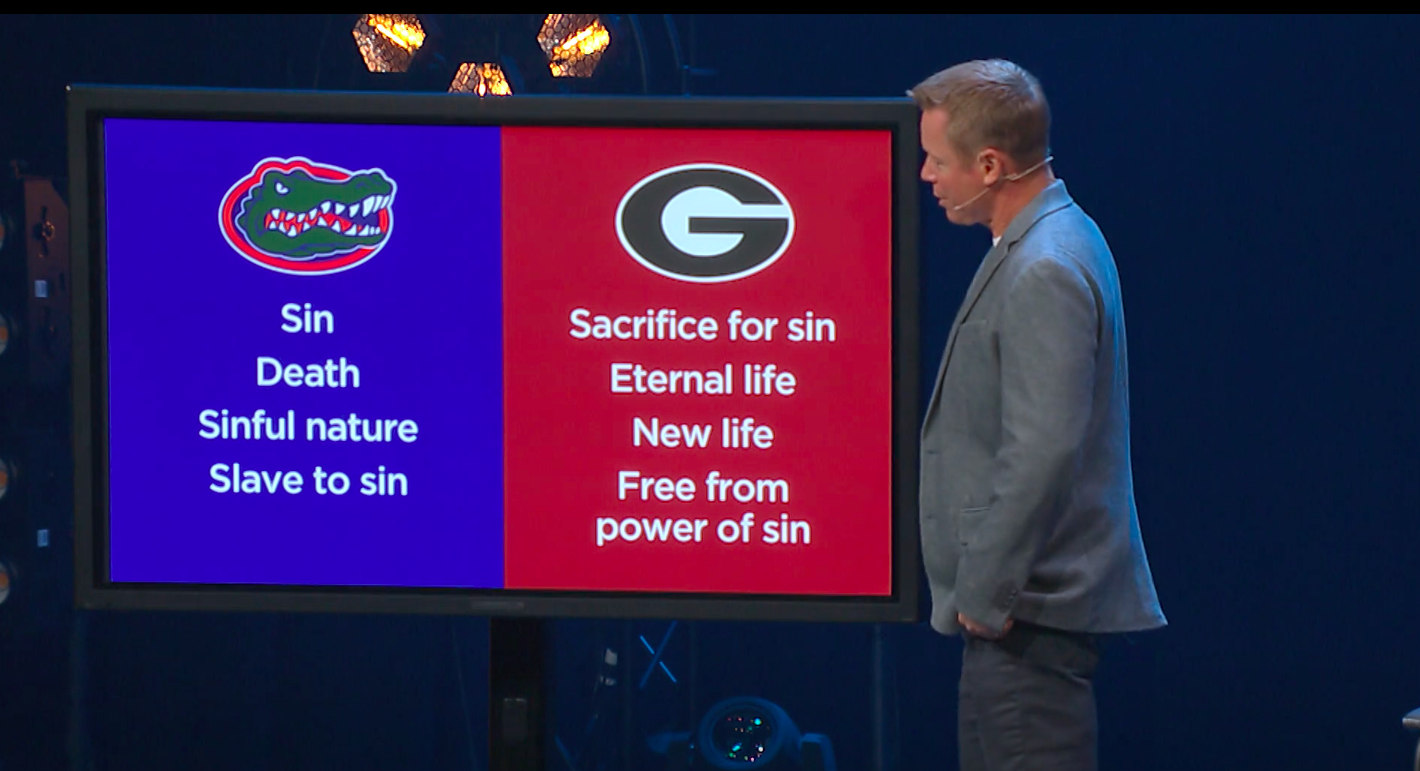
#ItMightMeanTooMuch: Context behind the Easter sermon with quite the Florida-UGA comparison
I had a feeling that Easter would yield at least one #ItMightMeanTooMuch talking point.
That’s why on Sunday morning, I fired off a tweet with the following message.
“Remember this, SEC fans: If your pastor likens Christ’s rise from the dead to your team’s climb out of the SEC basement, #ItMightMeanTooMuch.”
Why did I tweet that, you ask? Well, remember a few months ago when an Oxford pastor compared Jesus’ birth to Tennessee running through the “Power T” during his Christmas Eve sermon? I definitely do. I also remember the pastor of that sermon tweeting at me multiple times — without me ever responding or tagging him in any tweet related to the story — that I didn’t get the full story and I didn’t do my job well because of it.
Fast forward to Easter Sunday when, as fate would have it, another pastor had quite the Jesus comparison related to the SEC. This time, however, it took place at Athens Church in Georgia.
By now, you’ve probably seen this almost too obvious example of #ItMightMeanTooMuch:
Aaaaaaaaaaaaand #ItMightMeanTooMuchhttps://t.co/ZZV7x7eQrL
— Connor O'Gara (@cjogara) April 21, 2019
In that context, #ItMightMeanTooMuch is really the only response that one could have. Even some Georgia fans would probably look at that and go, “Alright. Let’s take it down a notch.”
Seeing that screenshot provided me with a good laugh and one more reason to think that the SEC really is a religion. It would have been easy for me to carry on with my life assuming that this pastor was just another person living in a college town who took sports a little too seriously.
But then I thought back to that Oxford pastor who blasted me on Twitter for saying I didn’t have any context. So, in an effort not to repeat that, I got some context. I watched 8 minutes of the lead-up to the pastor (Sean Seay) pulling out this all-too-stereotypical comparison.
Not to get too biblical on this platform, but what Seay was attempting to do was show what the disciple Paul talks about in Romans. On one side of this original graphic was Adam (the Florida side) and on the other side was Jesus (the Georgia side). Seay’s point was that we are born like Adam. That is, as slaves to sin. But because Jesus died for our sins and showed us the path to eternal life, we don’t have to live like Adam.
So roughly 20 minutes into his sermon, Seay essentially asked this hypothetical question.
“If Paul were explaining this theological concept of being in Adam or in Chris here in Athens, Georgia in 2019, what analogy would he make in this sports-oriented world?”
He removed Adam and Jesus from the graphic and replaced them with Florida and Georgia, respectively. It drew laughs from the Athens Church crowd. He then explained why it wasn’t an exact comparison and that it was a hypothetical.
The Florida-Georgia graphic was up there for roughly a minute of a 37-minute sermon … which was just enough time for at least one person to pull out their phone and get a picture of the image so that it could go semi-viral. Had that person not taken a picture of that, I certainly wouldn’t have seen it.
Here’s the thing.
I believe Seay had a point, and he drove it home the best way he could. To everyone who was in attendance or following along via a live stream, that Florida-Georgia comparison might have been the thing that snapped them out of their mid-church daydream (we’ve all been there). And while watching that clip showed that Seay made that analogy tongue-in-cheek, he knew he was playing to his church-going audience.
It’s a bit of a double-edged sword. On one hand, Seay had to know that a reference like that was going to feed into the stereotype and hit the masses. People like myself were going to tweet about it and he was going to look like the extreme southern pastor who took it a bit too far. In this age of everyone wanting to have an internet voice, no shortage of people were going to share opinions like this:
That would have been my last Sunday in that church. I never wear sports-related attire to church. Just don’t see it as the place for bringing that into it.
— Walt ? (@AU_GS_Walt) April 22, 2019
Everyone is entitled to their opinion. Many were probably made without watching a second of Seay’s sermon, and understandably so. We see something on social media that we have strong feelings about and we let out our knee-jerk reactions.
I wonder if those commenting on it would have felt the same way had they watched the lead-in. Maybe they would have. It’s possible that even a quick comparison rubbed some of Seay’s regulars the wrong way.
But at the same time, maybe Seay hoped to use this as an opportunity to expand the church’s platform. On Easter Sunday, one of the two most popular church days of the year, I’ll bet that far more people than usual listened to the message he preached about. In one of the replies — Seay retweeted the original tweet — was the link to the entire sermon.
Seay appreciated that being shared, as well as some context with it:
Thank you!
— Sean Seay (@seanseay) April 22, 2019
Say what you want about that analogy, but Seay certainly got his message out to more people than he would have had he preached the same Easter Sunday message that many hear on an annual basis.
Assuming his goal on Sunday was spreading the gospel in a way that would stick with people beyond Sunday, mission accomplished.
And if another goal was adding more fuel to the Florida-Georgia rivalry while going semi-viral on Easter Sunday, well, mission accomplished there, too.
Connor O'Gara is the senior national columnist for Saturday Down South. He's a member of the Football Writers Association of America. After spending his entire life living in B1G country, he moved to the South in 2015.






